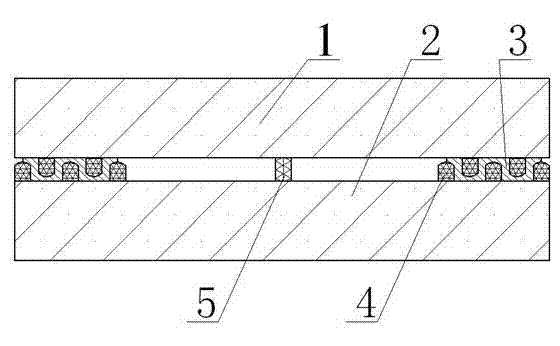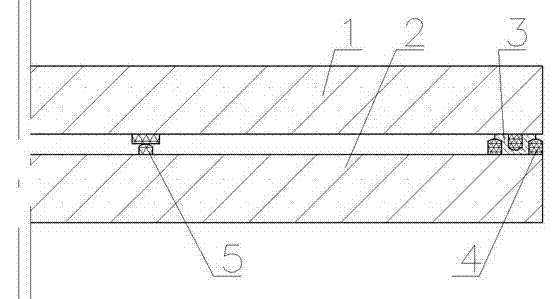Planar vacuum glass welded by metal solders in microwave manner and subjected to edge sealing by strip frames, and manufacturing method of glass
A vacuum glass and welding surface technology, which is applied in glass manufacturing equipment, glass production, glass molding, etc., can solve the problems of inappropriateness, restriction of radiation heat transfer, and large space occupied by auxiliary sealing strips, etc.
- Summary
- Abstract
- Description
- Claims
- Application Information
AI Technical Summary
Problems solved by technology
Method used
Image
Examples
Embodiment 1
[0058] Embodiment 1: see figure 1 , the vacuum glass is composed of upper and lower glass, one of which is low-emissivity glass, and its production method is as follows: first, cut a piece of flat glass and a piece of low-emission glass of the required size according to the shape and size of the vacuum glass to be produced, and then perform edge grinding, After chamfering, film removal, cleaning and drying, use a spray gun to spray low-temperature glass powder paste on the upper glass to make an edge banding frame, and use a polyester screen to print low-temperature glass powder paste on the lower glass to make an edge banding frame and supports, wherein the upper glass has two edge-seal frames, the lower glass has three edge-seal frames, the size of the upper glass edge-seal frame is between the lower glass edge-seal frames, The glass edge banding frame can be fitted between the lower glass edge banding frames, the width of each edge banding frame is 1.5mm, the height of the ...
Embodiment 2
[0061] Example 2: see figure 1 , the vacuum glass is composed of upper and lower pieces of glass, both of which are ordinary float glass. Corners, after cleaning and drying, use printing technology to print low-temperature glass powder paste on the upper glass and the lower glass to make edge banding frames, of which the upper glass has two edge banding frames, and the lower glass has three edge banding frames. The size of the upper glass edge seal frame is between the lower glass edge seal frames. After the upper and lower glass are combined, the edge seal frame of the upper glass can be embedded between the edge seal frames of the lower glass. Each edge seal The width of the frame is 1.2mm and the height is 0.4mm; secondly, the two pieces of glass are respectively sent into the high temperature furnace, and the edge sealing frame and the glass are sintered together under the action of high temperature of 550~650℃ in the high temperature furnace, and then lowered to room temp...
Embodiment 3
[0063] Embodiment 3: see figure 2 , one of the two pieces of vacuum glass is low-emissivity glass, and the other is tempered glass or half-tempered glass. Radiation glass, after grinding, chamfering, film removal, cleaning and drying, use printing technology to print low-temperature glass powder paste on the two pieces of glass to form an edge banding frame, in which the upper glass has an edge banding frame and the lower glass The glass has two edge banding frames. The size of the upper glass edge banding frame is between the two lower glass edge banding frames. After the upper and lower glass are combined, the upper glass edge banding frame can be embedded in the lower glass Between two edge banding frames, each edge banding frame has a width of 1.8mm and a height of 0.25mm; after the upper and lower glass are dried, a layer containing low-temperature glass powder is first printed or sprayed on the position of the edge banding frame Then print or spray a layer of commercia...
PUM
| Property | Measurement | Unit |
|---|---|---|
| melting point | aaaaa | aaaaa |
| height | aaaaa | aaaaa |
| width | aaaaa | aaaaa |
Abstract
Description
Claims
Application Information
 Login to View More
Login to View More - R&D
- Intellectual Property
- Life Sciences
- Materials
- Tech Scout
- Unparalleled Data Quality
- Higher Quality Content
- 60% Fewer Hallucinations
Browse by: Latest US Patents, China's latest patents, Technical Efficacy Thesaurus, Application Domain, Technology Topic, Popular Technical Reports.
© 2025 PatSnap. All rights reserved.Legal|Privacy policy|Modern Slavery Act Transparency Statement|Sitemap|About US| Contact US: help@patsnap.com



